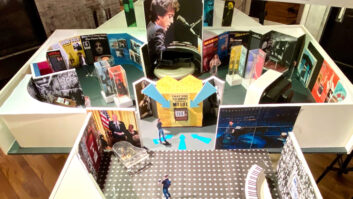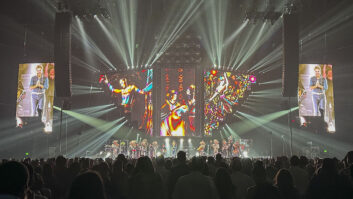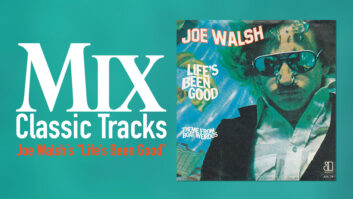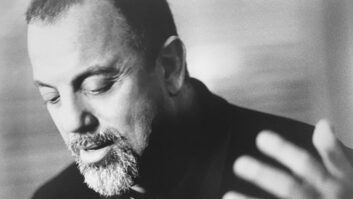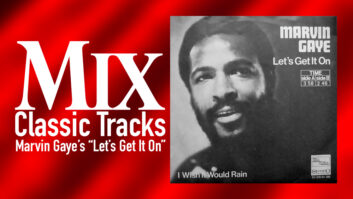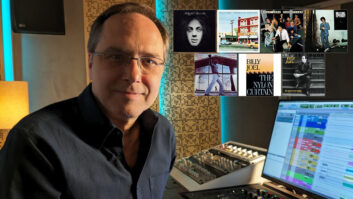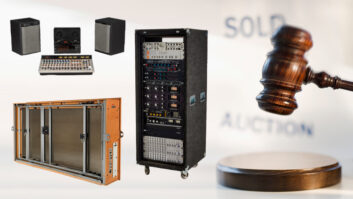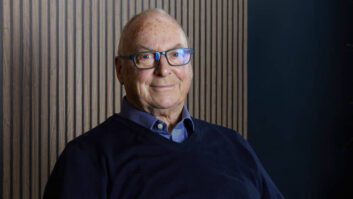
In early October, Mexican singing sensation Alejandro Fernandez’s latest album, Confidencias, leaped out of the box to Number One on Billboard’s Latin Pop charts, capping the biggest-selling week of Fernandez’s two-decade-plus career as a solo artist. It probably helped that this new offering consists largely of classic songs well-known in Latin America, and that eminent guests help out on three tracks—Christina Aguilera (“Hoy Tengo Ganas de Ti,” a hit download and video); Fernandez’s famous father, singer Vicente Fernandez (“Me Olvide de Viver”); and Rod Stewart, of all people (an English-and-Spanish duet big band version of “Nobody Knows You When You’re Down and Out”). Fernandez’s roots are in the Mexican ranchera tradition, but Confidencias is a pop work through and through, and with this album, the ruggedly handsome and versatile vocalist may have found a direction for the next phase of his career.
Part of what makes Confidencias of interest to Mix readers is the album’s impeccable American pedigree. It was recorded in Los Angeles—at Glenwood Place, EastWest and G Studio Digital—with the late Phil Ramone producing (one of his final projects), engineer Ed Cherney handling the instrumental tracking, and Frank Filipetti mixing at his Living Room studio in Nyack, N.Y., an hour north of Manhattan. The core band was made up of some of L.A.’s finest session players, including guitarist Dean Parks, bassist Kevin Axt, keyboardist Jim Cox and drummer Gregg Field. The sometimes lush arrangements are by some of the best in the business, too, including Jorge Calandrelli, Gordon Goodwin, Rob Mounsey and Doug Katsaros, with considerable input from Ramone, himself an impeccable authority on arrangement.
The musicians who convened with Ramone and Cherney in the SSL 9K-equipped Studio A at Glenwood Place in Burbank in July 2012 were among the “regulars” Ramone tapped when he’d work on the West Coast. For instance, drummer Field had worked with Ramone on more than 30 projects since meeting the producer during Frank Sinatra’s Duets album in 1993, and the two became close through the years—“When he’d come out to L.A. to work, he’d usually stay at my home [in Studio City],” Field says. “We had what we called ‘the Phil Ramone suite,’ where he had some clothes and he knew he was always welcome.
“I have a studio that was built by Studio Bau:ton in 2000, and Phil used that on many projects, including the Alejandro Fernandez album. That’s where we did all of the vocals and all the editing. It’s attached to my home, but it’s got its own parking and it is its own structure, so Phil literally just had to walk down the stairs and he was there. It was the main Concord Records studio from 2000 to 2008,” says Field, who, besides being a first-call drummer, has worked in production and business development for the Concord Music Group for many years.
Engineer Cherney had recorded all the musicians in the core band but, amazingly enough, had never worked with Ramone, a friend of his for more than a quarter-century. “I was always thinking, ‘What am I, chopped liver?’” Cherney says with a laugh. “But Phil had his guys out here he usually worked with, like Al Schmitt. But one day he called me and we ended up doing two records almost simultaneously—Alejandro’s and one by Matthew Morrison, which we also tracked at Glenwood, immediately after Alejandro’s.”

Phil Ramone
Even though Cherney has worked with some of the biggest acts in the world and is one of the most respected engineers in L.A., he admits that he was “really nervous” about working with Ramone. “I wondered, ‘What if I’m not good enough?’ So I did a lot of planning for the sessions. I was there four hours early, figuring how to set it up so it would be perfect for Phil, so the sightlines were right and all the mics were right. We started running the songs down, and the musicians were so good it was easy to get sounds on them—easy to get a balance, easy to get a great recording. You get a microphone close to any of these guys and they sound great. It was a piece of cake. Still I was nervous, but pretty early on, Phil whispered in my ear, ‘It sounds great.’ Usually you don’t hear about something unless there’s a problem, so that made me feel really good, and we ended up having the best time.”
Cherney describes the live tracking sessions as “very straightforward.” Fields’ drums were miked with an Audio-Technica ATM23HE on top of the snare and a Sennheiser 441 underneath, AT25s on toms, a B&K 4011 on hi-hat, Coles ribbons for the overheads, and for the drum room, a single Neumann U 87 in omni “EQ’d and compressed within an inch of its life,” Cherney says. “For the piano I used a couple of [AKG] C12As in X/Y with a FET 47 on the low end. Electric guitar had a Royer 121 on the amps, and I used a combo of Neumann U 67 and KM 84s on acoustic guitar, dobro, lap steel, mando, etc.” Cherney says the bulk of the instrumental overdubs were done immediately after the live group tracking for a given song was completed.
Fernandez laid down scratch vocals for some tunes, “which really helped us focus on what we needed to do [as a band],” Field notes. But on some songs during the basic tracking, Fernandez’s vocal director, Áureo Baqueiro, sang with the band. Baqueiro was also on hand to help produce the later vocal sessions at G Studio Digital, which were engineered by Jorge Velasco, a native Spanish-speaker from Colombia who had worked as Cherney’s assistant on the tracking dates at Glenwood Place. According to Field, the vocal chain for Fernandez consisted of a U 67, a Millennia mic pre “and something Al Schmitt turned me onto years ago, a Studer [D19] Mic Valve [preamp].” The board in Field’s studio is an Avid D-Command. The guest vocals by Aguilera, Stewart and Fernandez (Sr.) were done separately in other studios and sent in later.
After the vocals were completed, the action moved to EastWest’s historic Studio One, for orchestra, brass and reed overdubs. Cherney says he was slightly apprehensive going into the EastWest sessions, too: “Phil has done so many orchestral sessions; it’s one of the things he did best. But it’s a great room with a superb mic closet, and when you have arrangers like Jorge Calandrelli—and in the afternoon it might be Gordon Goodwin, who did the more jazzy horn things—it’s hard to mess up.
“For the strings, we had [three] Neumann M 50s on a Decca Tree. Spot mics were C12s on violins, U 67s on violas, KM 86s on celli and FET 47s on basses. For horns I also used the Decca Tree with M 50s, but used more spots—Royer 121s on trumpets and ’bones, U 67s on woodwinds and French horns. For some of the arrangements, we did strings and horns at the same time, and others we did separately.” Studio One’s control room is equipped with classic Neve 8078 console.
Next, the Pro Tools sessions went to Frank Filipetti, who mixes completely in the box these days, on an Avid D-Command, using plug-ins exclusively, rather than traditional outboard gear. “For the most part I got a finished record [from Cherney and Ramone], and I just needed to mix it. There were a couple of things that came in late, like Rod’s vocal, but that was no problem.”

Gregg Field
What sort of reverbs did Filipetti use on Fernandez’s all-important lead vocals? “I used a variety of different ones I have set up, and then I matched them to each track. I used a lot of the UAD EMT 140 and the EMT 250. I also used several different Lexicon [plug-ins]—the hall, the plate and the chamber program. I’ll use the EMT 250 to handle the shorter ’verbs, and then the longer ones will be either the 140 or one of the Lexicon chambers. Then I’ll probably mix in a little of the either [UAD] Echoplex or the [Sound Toys] EchoBoy, depending on what sort of sound I’m looking for.” Speaking more generally of Fernandez’s vocals, Filipetti says, “I was really knocked out when I first got the vocals. He’s able to do that thing that very few singers can do, which is turn on a dime, from full-out to whisper-quiet, and still make it all feel real. That’s a unique talent that few pop singers of today understand.”
When it came to mixing in the orchestral elements, Filipetti says he used about a 50-50 blend of recordings from the Decca Tree arrays and the spot mics. He comments, “When you’re listening to an orchestra, it’s really great to listen to it from the Tree. But when you start sparkling up the guitars and the drums and doing all that stuff you do in the final mix, the tree can start to sound a little amorphous. It’s wonderful for the classical approach, but we were going for a more pop approach, so it was nice to have the spots available. By the way…so often as a mixer I end up spending half of my time fixing instead of mixing. It was such a joy to get Ed’s tracks and honestly just mix.”
For everyone who worked on Confidencias, the album’s success has been somewhat bittersweet. After all, Ramone is not around to enjoy its popularity.
“We all miss him so much,” says Field, who says he used to speak with Ramone “almost daily for the past 10 years. Besides being a great guy, he imparted so much knowledge to all of us who had the opportunity to work with him. He was always the calm voice in the studio, and he also could lighten the mood if things were getting tense—which they never did on Alejandro’s record. He was very efficient yet also very relaxed. His attitude was: ‘Let’s have fun and make a great record.’”
“This was a love-fest,” Cherney offers. “It was fun; they’re not always fun. Phil had the exuberance of a child—that sense of wonder. When something good was happening, his face would light up like an 8-year-old on Christmas morning. He never lost that.”
“I think all of us who were involved with this record are very proud of it,” adds Filipetti, who worked with Ramone on more projects than he can count. “I never knew what we were going to do next or where we might go. I’d get a call from him: ‘Okay, we’re going to Argentina in two weeks to work on a Fito Páez record.’ ‘Okay, we’re going to Modena, Italy to work with Pavarotti.’ ‘Now we’re going to Paris to work with Patricia Kaas.’ That’s what the last 20 years of my life has been like with Phil. It’s going to be a long, long time before there’s anyone like him again.”
